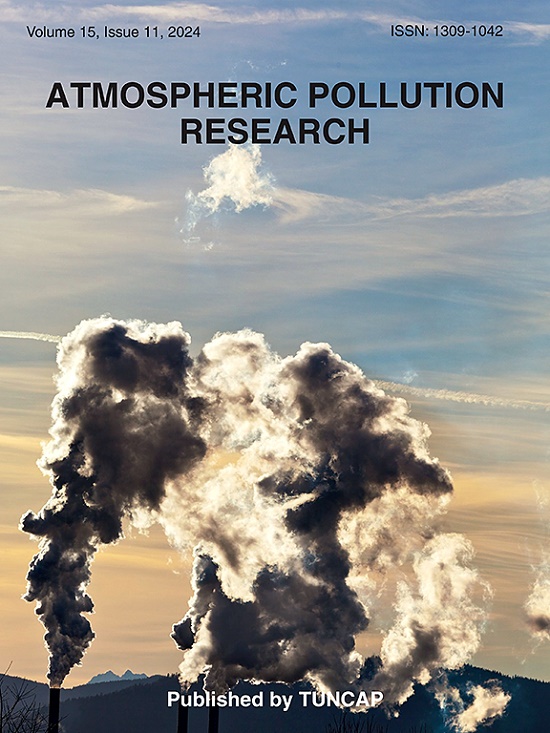东北某特大城市pm2.5重金属污染特征及时间趋势:对大气污染控制政策效果的启示
IF 3.5
3区 环境科学与生态学
Q2 ENVIRONMENTAL SCIENCES
引用次数: 0
摘要
特别是在寒冷地区,由于空间供暖的煤炭燃烧增加,pm2.5结合的重金属具有重大的健康风险。本研究于2021年8月至2022年7月对中国东北特大城市哈尔滨市进行了为期一年的pm2.5重金属综合观测。结果表明,锌(Zn)和铬(Cr)是主要重金属,浓度分别为47 ng/m3和41 ng/m3。值得注意的是,Cr(VI)的水平超过了世界卫生组织的指导方针和中国环境空气质量标准。除Cr外,其他重金属在采暖期的浓度均显著高于非采暖期。通过源划分,两期均以交通排放和燃煤为主要源,采暖期以燃煤为主导源。健康风险评估显示,砷对婴幼儿的非致癌风险,而大多数元素的致癌风险超过了10 - 6的阈值。在加热期和非加热期,镍(Ni)和铬(VI)分别成为主要致癌元素。一项比较评估显示,目标重金属浓度大幅下降,与2013年相比总体下降了75.9%。重要的是,供暖期占这一减少的65.6%,这表明空气污染控制政策的有效性,特别是那些旨在减少燃煤排放的政策。因此,针对重金属的具体来源制定控制政策至关重要。本文章由计算机程序翻译,如有差异,请以英文原文为准。

Pollution characteristic and temporal trend of PM2.5-bound heavy metals in a megacity of Northeast China: Implication for the effect of air pollution control policy
PM2.5-bound heavy metals present significant health risks especially in cold regions due to the enhanced coal combustion for space heating. This study conducted a comprehensive one-year observation of PM2.5-bound heavy metals in Harbin City, a megacity in Northeast China, from August 2021 to July 2022. The findings revealed that zinc (Zn) and chromium (Cr) were the dominant heavy metals, with concentrations of 47 ng/m3 and 41 ng/m3, respectively. Notably, the levels of Cr(VI) exceeded both the WHO guidelines and the Chinese Ambient Air Quality Standards. Except for Cr, the concentrations of other heavy metals were significantly higher during the heating period than the non-heating period. Based on source apportionment, traffic emission and coal combustion were recognized as the primary sources in both periods, while coal combustion was the dominant source in the heating period. Health risk assessments revealed non-carcinogenic risk from arsenic (As) for infants and toddlers, while carcinogenic risk for most elements surpassed the threshold of 10−6. Nickel (Ni) and Cr(VI) emerged as the principal carcinogenic elements during the heating period and non-heating period, respectively. A comparative assessment demonstrated a substantial decline in the concentrations of targeted heavy metals, with an overall reduction of 75.9% compared to 2013. Importantly, the heating period accounted for 65.6% of this reduction, suggesting the effectiveness of air pollution control policies, especially those aimed at reducing coal combustion emissions. Therefore, the control policy addressing the specific sources of heavy metals is essential.
求助全文
通过发布文献求助,成功后即可免费获取论文全文。
去求助
来源期刊

Atmospheric Pollution Research
ENVIRONMENTAL SCIENCES-
CiteScore
8.30
自引率
6.70%
发文量
256
审稿时长
36 days
期刊介绍:
Atmospheric Pollution Research (APR) is an international journal designed for the publication of articles on air pollution. Papers should present novel experimental results, theory and modeling of air pollution on local, regional, or global scales. Areas covered are research on inorganic, organic, and persistent organic air pollutants, air quality monitoring, air quality management, atmospheric dispersion and transport, air-surface (soil, water, and vegetation) exchange of pollutants, dry and wet deposition, indoor air quality, exposure assessment, health effects, satellite measurements, natural emissions, atmospheric chemistry, greenhouse gases, and effects on climate change.
 求助内容:
求助内容: 应助结果提醒方式:
应助结果提醒方式:


